Pollution Characteristics and Ecological Risk Assessment of Heavy Metals in Sediments of the Three Gorges Reservoir
Abstract
1. Introduction
2. Materials and Methods
2.1. Sample Collection
2.2. Laboratory Analysis
2.3. Pollution Degree Evaluation Methods
2.3.1. Geoaccumulation Index (Igeo)
2.3.2. Potential Ecological Risk Index
2.3.3. Data Processing
3. Results
3.1. The Concentration Distribution Characteristics of Heavy Metals in the Surface Sediments of the Three Gorges Reservoir
3.2. Evaluation of Pollution Degree of Heavy Metals in the Surface Sediments of the Three Gorges Reservoir
3.2.1. Geoaccumulation Index (Igeo)
3.2.2. Potential Ecological Risk Index
4. Discussion
4.1. Distribution of Heavy Metal Pollution in Surface Sediments of the Three Gorges Reservoir
4.2. Sources of Heavy Metals in the Three Gorges Reservoir
5. Conclusions
Author Contributions
Funding
Acknowledgments
Conflicts of Interest
References
- Pitacco, V.; Mistri, M.; Ferrari, C.R.; Sfriso, A.; Munari, C. Multiannual Trend of Micro-Pollutants in Sediments and Benthic Community Response in a Mediterranean Lagoon (Sacca di Goro, Italy). Water 2020, 12, 1074. [Google Scholar] [CrossRef]
- Hiller, E.; Jurkovic, L.; Sutriepka, M. Metals in the Surface Sediments of Selected Water Reservoirs, Slovakia. Bull. Environ. Contam. Toxicol. 2010, 84, 635–640. [Google Scholar] [CrossRef]
- El Nemr, A.; El-Said, G.F.; Ragab, S.; Khaled, A.; El-Sikaily, A. The distribution, contamination and risk assessment of heavy metals in sediment and shellfish from the Red Sea coast, Egypt. Chemosphere 2016, 165, 369–380. [Google Scholar] [CrossRef] [PubMed]
- El Bilali, L.; Rasmussen, P.E.; Hall, G.; Fortin, D. Role of sediment composition in trace metal distribution in lake sediments. Appl. Geochem. 2002, 17, 1171–1181. [Google Scholar] [CrossRef]
- Natali, C.; Bianchini, G. Natural vs anthropogenic components in sediments from the Po River delta coastal lagoons (NE Italy). Environ. Sci. Pollut. Res. 2018, 25, 2981–2991. [Google Scholar] [CrossRef]
- Sun, W.; Xiao, E.; Dong, Y.; Tang, S.; Krumins, V.; Ning, Z.; Sun, M.; Zhao, Y.; Wu, S.; Xiao, T. Profiling microbial community in a watershed heavily contaminated by an active antimony (Sb) mine in Southwest China. Sci. Total Environ. 2016, 550, 297–308. [Google Scholar] [CrossRef]
- Zhuo, H.; Sun, Z.; Tan, L.; Wu, Y.; Lan, J. Temporal and Spatial Variation Characteristics of the Heavy Metals Content in the Surface Sediment and the Potential Ecological Risk Trends in the Three Gorges Reservoir Area. Huan Jing Ke Xue 2016, 37, 4633–4643. [Google Scholar]
- Tam, N.; Wong, Y.S. Spatial variation of heavy metals in surface sediments of Hong Kong mangrove swamps. Environ. Pollut. 2000, 110, 195–205. [Google Scholar] [CrossRef]
- Zhang, Y.; Shi, T.; Zhang, Y.; Yu, T. Spatial distribution and risk assessment of heavy metals in sediments from a hypertrophic plateau lake Dianchi, China. Environ. Monit. Assess. 2014, 186, 1219–1234. [Google Scholar]
- Yi, Y.; Sun, J.; Tang, C.; Zhang, S. Ecological risk assessment of heavy metals in sediment in the upper reach of the Yangtze River. Environ. Sci. Pollut. Res. 2016, 23, 11002–11013. [Google Scholar] [CrossRef] [PubMed]
- Shu-Jie, Y.U.; Ming, L.I.; Zhang, B.J.; Gan, H.H. Heavy Metal Pollution in Sediments of Main Irrigation Water Sources in Zhongshan City and Its Potential Ecological Risk Assessment. J. Anhui Agric. Sci. 2016, 44, 61–63. [Google Scholar]
- Haijian, B.; Yanhong, W.; Jun, Z.; Hongyang, S.; Xiaoxiao, W.; He, Z. Spatial variation of heavy metal contamination in the riparian sediments after two-year flow regulation in the Three Gorges Reservoir, China. Sci. Total Environ. 2019, 649, 1004–1016. [Google Scholar]
- Tang, Q.; Bao, Y.; He, X.; Zhou, H.; Cao, Z.; Gao, P.; Zhong, R.; Hu, Y.; Zhang, X. Sedimentation and associated trace metal enrichment in the riparian zone of the Three Gorges Reservoir, China. Sci. Total Environ. 2014, 479, 258–266. [Google Scholar] [CrossRef]
- Bing, H.; Wu, Y.; Zhou, J.; Li, R.; Wang, J. Historical trends of anthropogenic metals in Eastern Tibetan Plateau as reconstructed from alpine lake sediments over the last century. Chemosphere 2016, 148, 211–219. [Google Scholar] [CrossRef] [PubMed]
- Wei, X.; Han, L.; Gao, B.; Zhou, H.; Lu, J.; Wan, X.J.E.I. Distribution, bioavailability, and potential risk assessment of the metals in tributary sediments of Three Gorges Reservoir: The impact of water impoundment. Ecol. Indic. 2016, 61, 667–675. [Google Scholar] [CrossRef]
- Wei, Z.; Jian, X.U. Assessing Contents and Pollution of Heavy Metals within the Sediment Deposits in the Main Streams of the Three Gorges Reservoir. Irrig. Drain. 2018, 37, 99–105. [Google Scholar]
- Yan, X.; Yang, X.; Huang, X.; Dong, J.; Wang, M.; Han, R.; Wang, G.; Environment, S.O.; University, N.N. Distribution and Risk Assessment of Heavy Metals in the Surface Estuarine Sediments of Main Inflow Rivers in Taihu Lake. Ecol. Environ. Sci. 2016, 25, 1515–1521. [Google Scholar]
- Xiao, X.; Guan, D.; Jia, H. Heavy mental pollution in sediments from the three gorges reservoir area. Acta Hydrobiol. Sin. 1999, 1, 1–10. [Google Scholar]
- Wang, J.K.; Gao, B.; Zhou, H.D. Heavy Metals Pollution and Its Potential Ecological Risk of the Sediments in Three Gorges Reservoir During Its Impounding Period. Huan Jing Ke Xue 2012, 33, 1693–1699. [Google Scholar]
- Ning, Z.P.; Lan, X.L.; Huang, Z.Y.; Chen, H.Y.; Zhao, Y.L. Spatial distribution characteristics, sources and potential ecological risk of heavy metals in sediments of the Hejiang River. China Environ. Sci. 2017, 37, 3036–3047. [Google Scholar]
- Müller, G.; Förstner, U. Heavy metals in sediments of the rhine and elbe estuaries: Mobilization or mixing effect. Environ. Geol. 1975, 1, 33–39. [Google Scholar] [CrossRef]
- Hankanson, L. An ecological risk index for aquatic pollution-control-a sedimentological approach. Water Res. 1980, 14, 975–1001. [Google Scholar] [CrossRef]
- Ding, T.T.; Li, Q.; Du, S.L.; Wang, H.L.; Meng, T.; Chen, J.Y.; Zhang, Y.H.; He, L.S. Pollution characteristics and ecological risk assessment of heavy metals in Shaying River Basin. Environ. Chem. 2019, 38, 2386–2401. [Google Scholar]
- Wilding, L. Spatial variability: Its documentation, accommodation and implication to soil surveys. In Soil Spatial Variability; Nielsen, D.R., Bouma, J., Eds.; Pudoc: Wageningen, The Netherlands, 1985; pp. 166–194. [Google Scholar]
- Zhu, H.; Bing, H.; Wu, Y.; Zhou, J.; Sun, H.; Wang, J.; Wang, X. The spatial and vertical distribution of heavy metal contamination in sediments of the Three Gorges Reservoir determined by anti-seasonal flow regulation. Sci. Total Environ. 2019, 664, 79–88. [Google Scholar] [CrossRef]
- Zhu, S.; Zang, X. Heavy Metal Pollution along the Yangtze River Stretches of Urban Area in Major Cities. Yangtze River 2001, 33, 58–62. [Google Scholar]
- Jia, X.; Wang, C.; Zeng, X. The occurrence, accumulation and preliminary risk assessment of heavy metals in sediments from the main tributaries in the Three Gorges Reservoir. Geochimica 2014, 43, 174–179. [Google Scholar]
- Mar, S.S.; Okazaki, M. Investigation of Cd contents in several phosphate rocks used for the production of fertilizer. Microchem. J. 2012, 104, 17–21. [Google Scholar] [CrossRef]
- Wu, Q.; Qi, J.; Xia, X. Long-term variations in sediment heavy metals of a reservoir with changing trophic states: Implications for the impact of climate change. Sci. Total Environ. 2017, 609, 242–250. [Google Scholar] [CrossRef]
- Xu, M.; Sun, W.; Wang, R. Spatial Distribution and Ecological Risk Assessment of Potentially Harmful Trace Elements in Surface Sediments from Lake Dali, North China. Water 2019, 11, 2544. [Google Scholar] [CrossRef]
- Naghavi, K.; Saion, E.; Abdi, M.R.; Soltani, N.; Saraee, K.R.E.; Shafaei, M.A. Distribution of heavy metals in surface sediments from the South China Sea ecosystem, Malaysia. Environ. Monit. Assess. 2011, 183, 545–554. [Google Scholar]
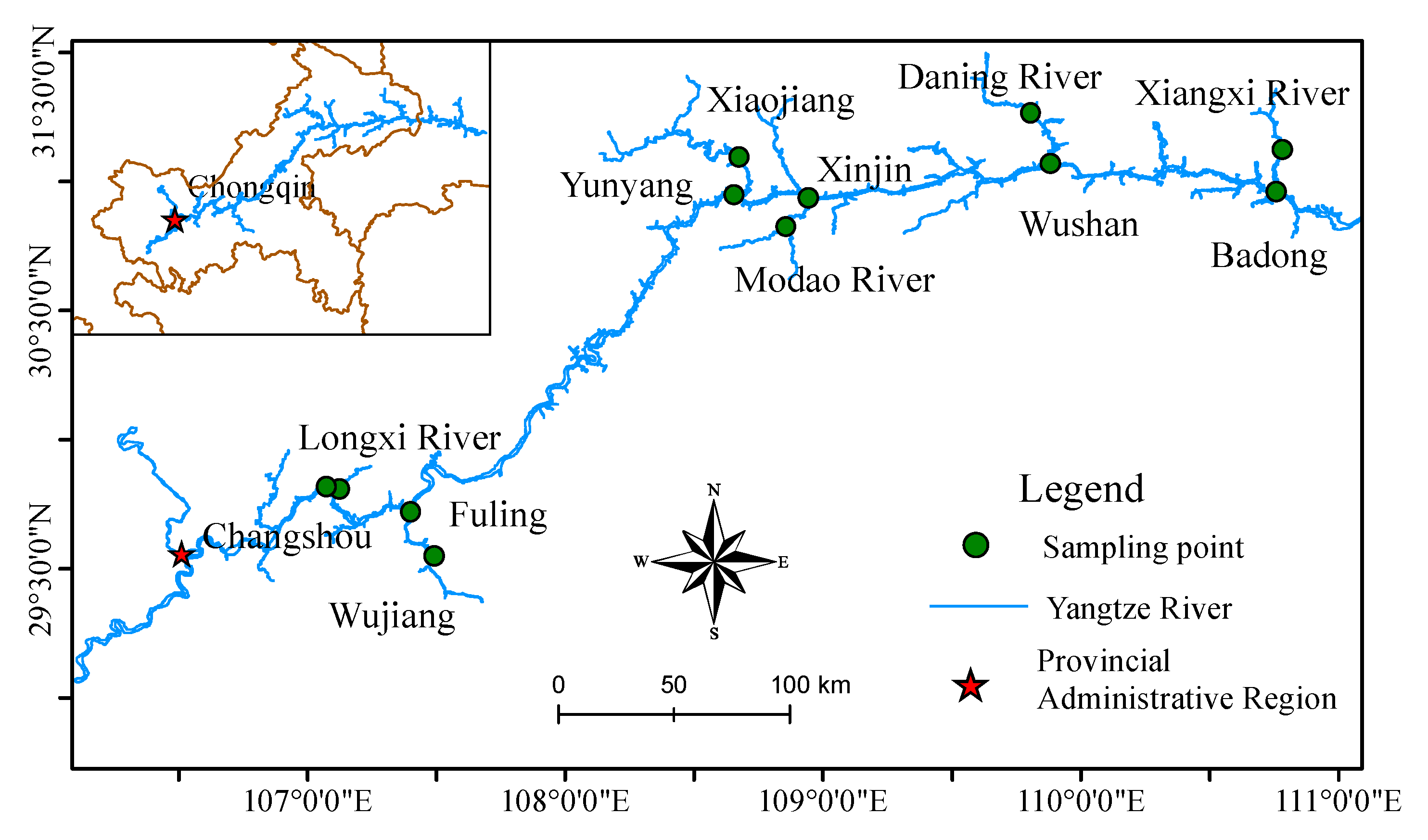
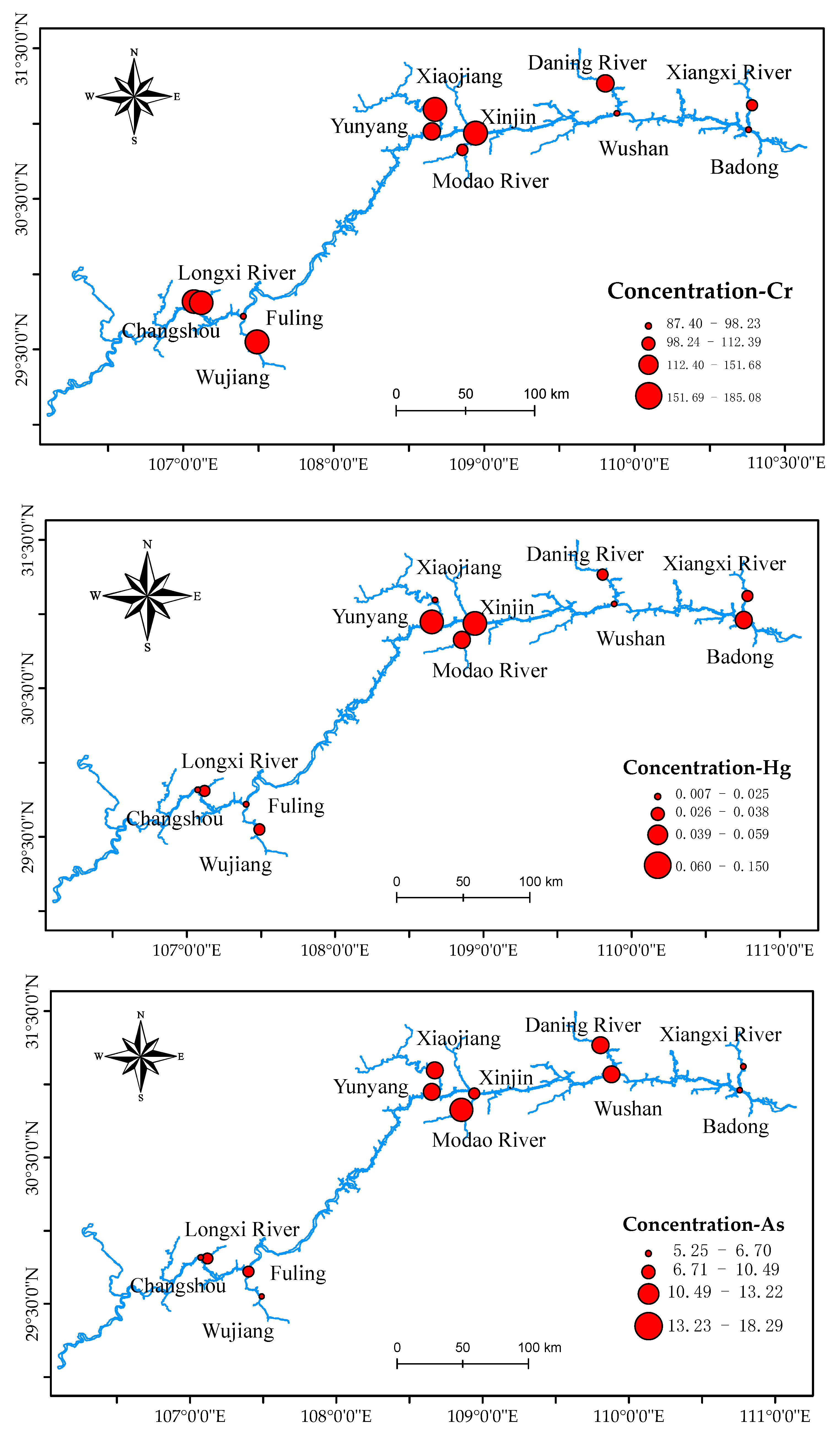
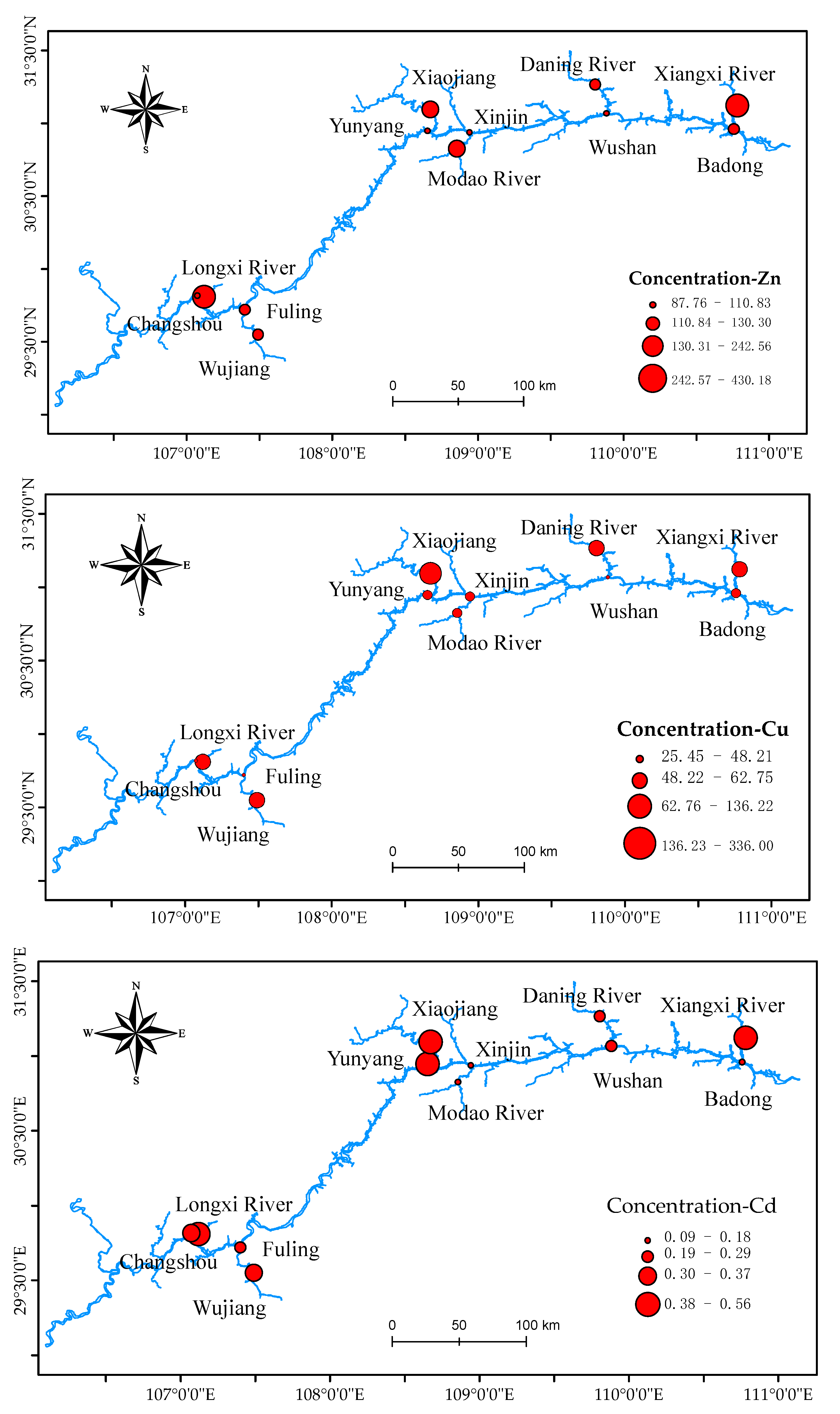
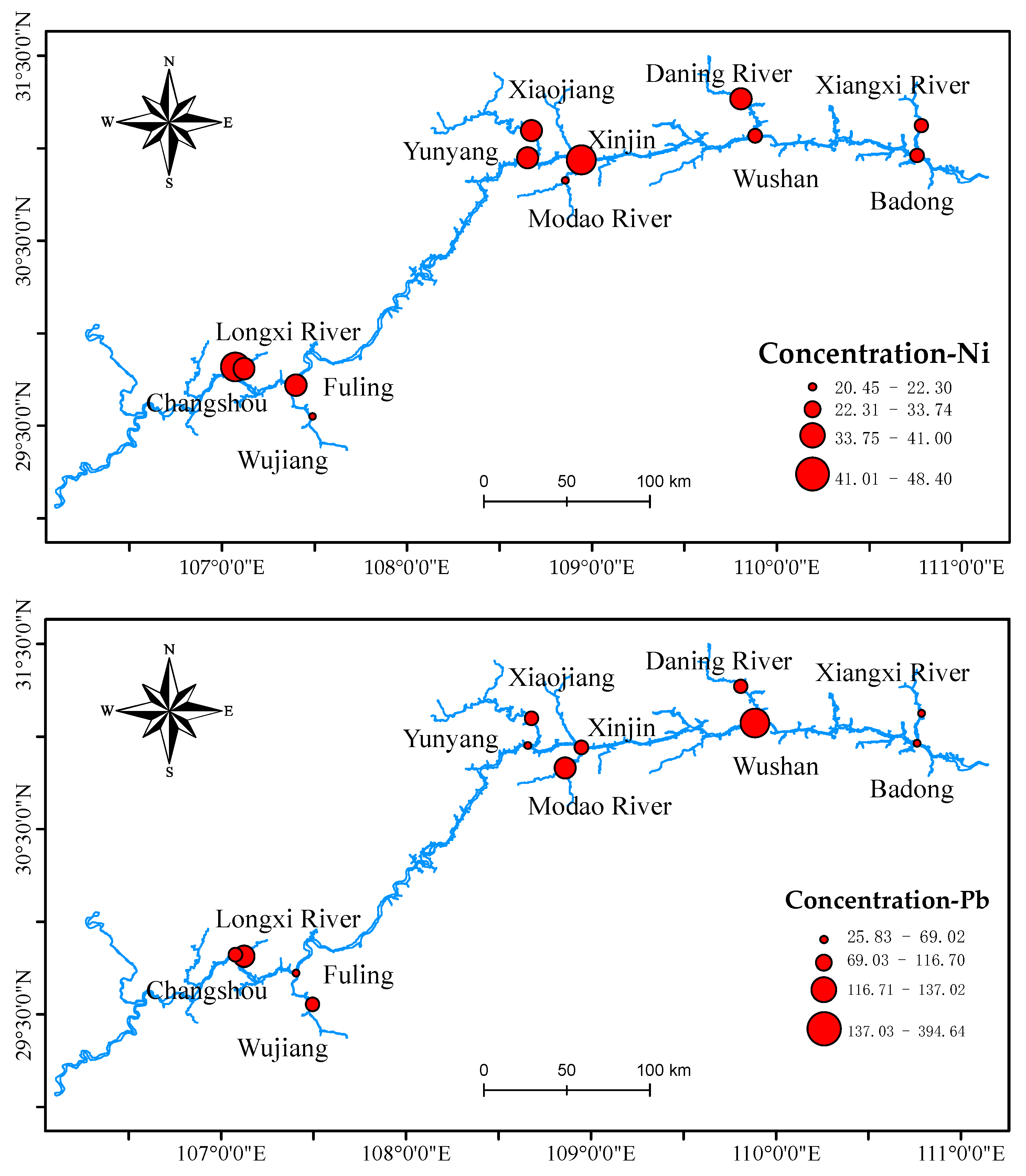
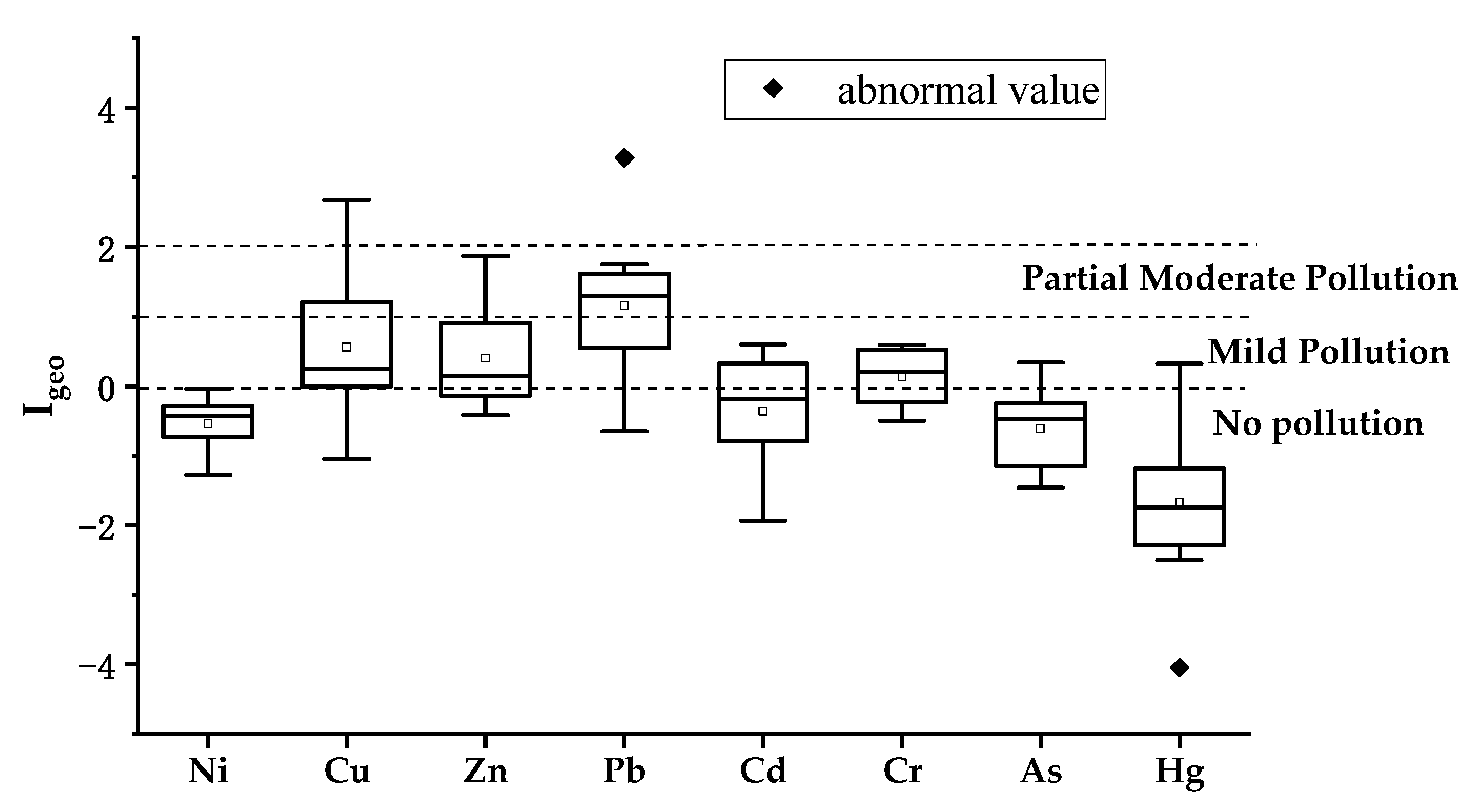
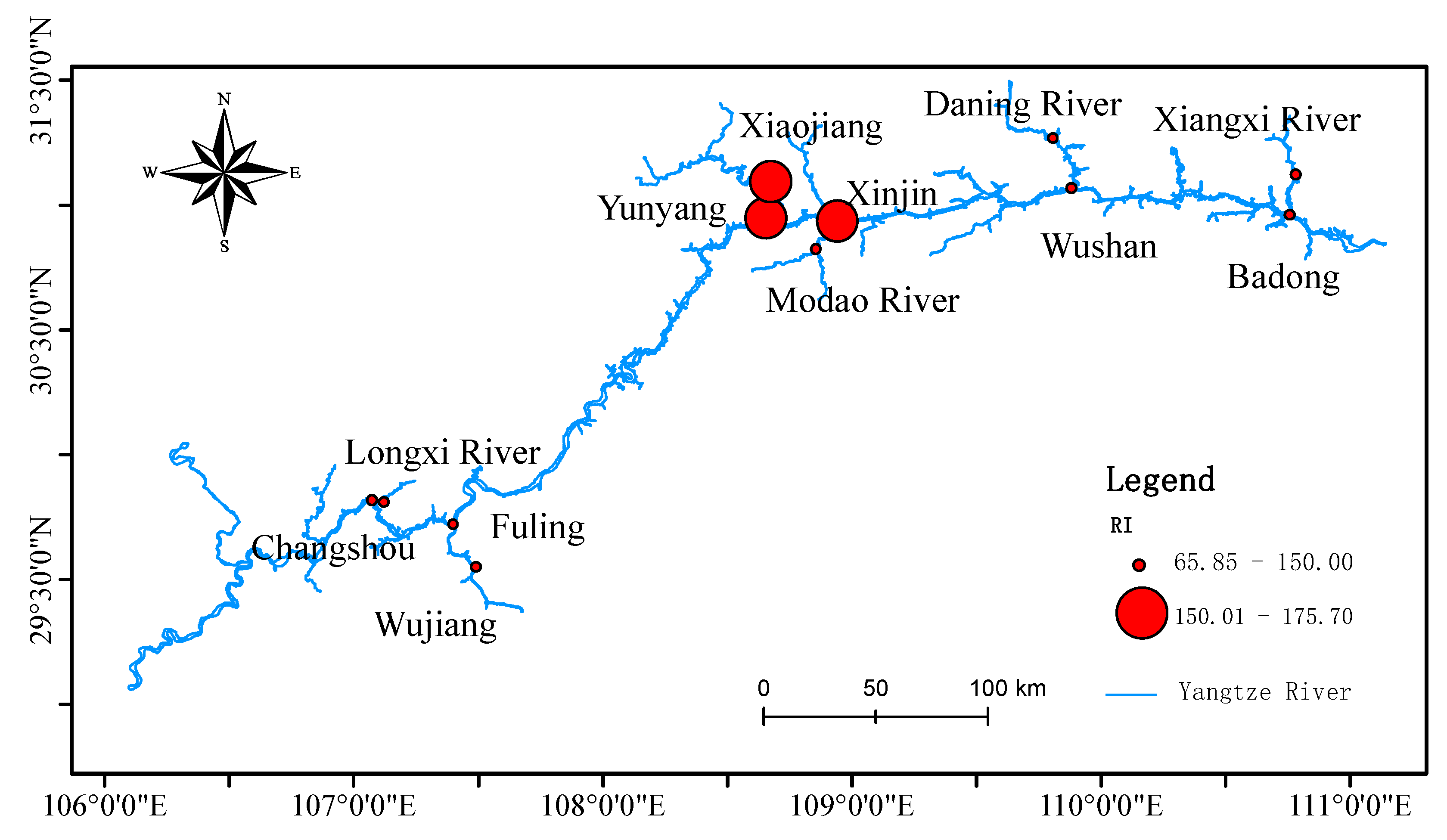
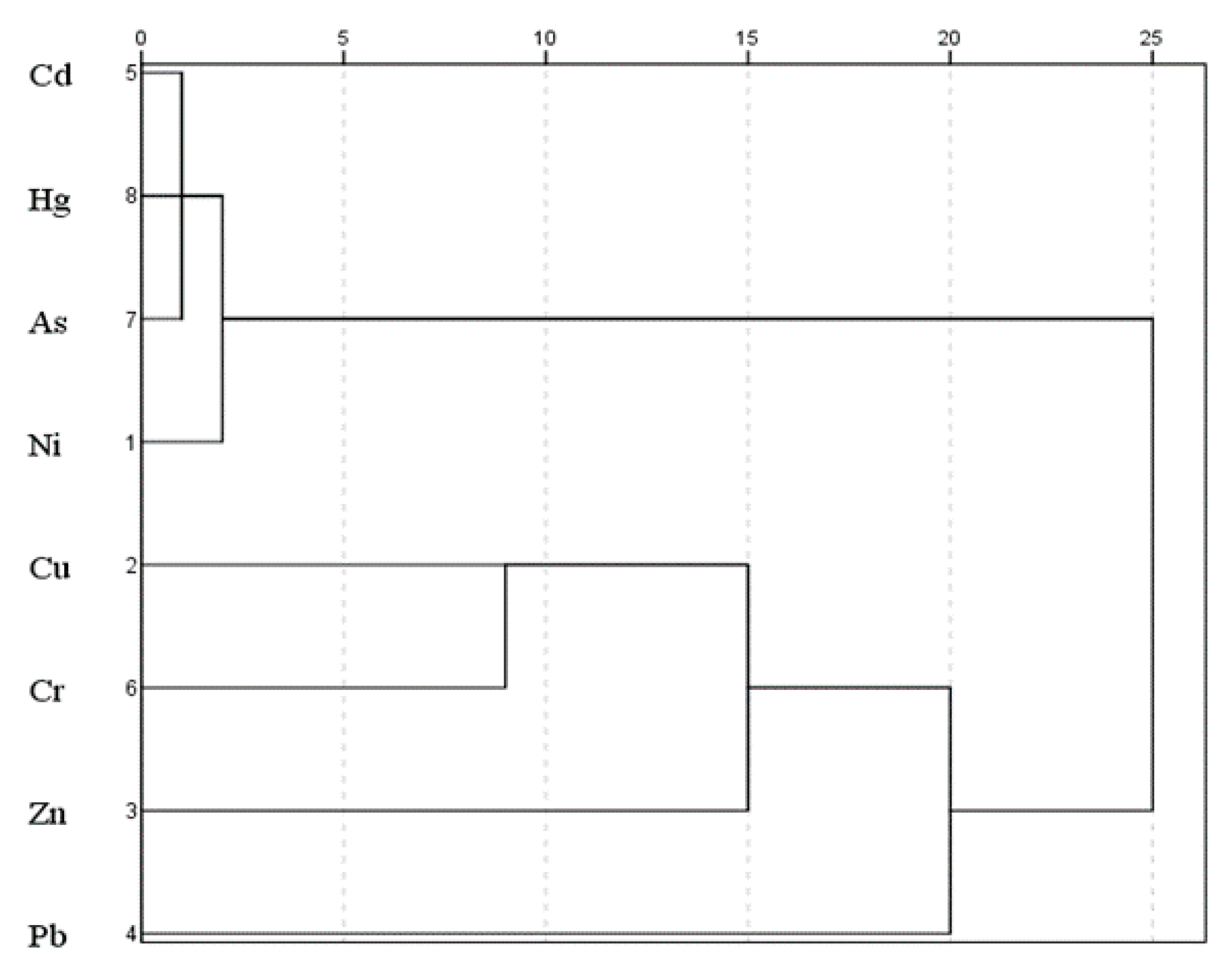
| Project | Igeo | ||||||
|---|---|---|---|---|---|---|---|
| <0 | 0–1 | 1–2 | 2–3 | 3–4 | 4–5 | 5–6 | |
| Series | 0 | 1 | 2 | 3 | 4 | 5 | 6 |
| Degree | No pollution | Mild | Partial Moderate | Moderate | Partial Heavy | Heavy | Serious |
| Single Pollutant Pollution Index | Potential Ecological Risk Index RI | ||
|---|---|---|---|
| Threshold Interval | Degree | Threshold Interval | Degree |
| < 40 | Low | RI < 150 | Low |
| 40 ≤ < 80 | Middle | 150 ≤ RI < 300 | Middle |
| 80 ≤ < 160 | High | 300 ≤ RI < 600 | High |
| 160 ≤ < 320 | Very high | 600 ≤ RI < 1200 | Very high |
| ≥ 320 | Extremely high | RI ≥ 1200 | Extremely high |
| Element | Minimum | Maximum | Average | Standard Deviation | Coefficient of Variation (%) | Over-Standard Rate (%) | Background Value of Yangtze River Sediment [18] | National Second-Level Standard for Soil Quality a |
|---|---|---|---|---|---|---|---|---|
| mg/kg | mg/kg | mg/kg | mg/kg | mg/kg | ||||
| Ni | 20.45 | 48.40 | 35.17 | 8.36 | 23.77 | 0 | 33 | 90 |
| Cu | 25.46 | 336.0 | 97.72 | 82.84 | 84.78 | 33.33 | 35 | 100 |
| Zn | 87.77 | 430.2 | 177.0 | 108.4 | 61.24 | 16.67 | 78 | 250 |
| Pb | 25.83 | 394.7 | 114.1 | 95.30 | 83.53 | 66.67 | 27 | 80 |
| Cd | 0.10 | 0.57 | 0.33 | 0.16 | 46.69 | 16.67 | 0.25 | 0.50 |
| Cr | 87.40 | 185.1 | 140.3 | 38.62 | 27.54 | 0 | 82 | 300 |
| As | 5.25 | 18.29 | 10.08 | 3.80 | 37.63 | 0 | 9.6 | 25 |
| Hg | 0.01 | 0.15 | 0.05 | 0.04 | 87.68 | 0 | 0.08 | 0.50 |
| Project | Potential Ecological Risk Index | |||||||
|---|---|---|---|---|---|---|---|---|
| Ni | Cu | Zn | Pb | Cd | Cr | As | Hg | |
| Average | 5.33 | 13.96 | 2.27 | 21.13 | 39.85 | 3.42 | 10.50 | 25.38 |
| Minimum | 3.10 | 3.64 | 1.13 | 4.78 | 11.77 | 2.13 | 5.47 | 3.63 |
| Maximum | 7.33 | 48.00 | 5.52 | 73.08 | 68.30 | 4.51 | 19.05 | 75.29 |
| Year | Ni | Cu | Zn | Pb | Cd | Cr | As | Hg |
|---|---|---|---|---|---|---|---|---|
| 1999 [18] | 36.94 | 62.54 | 160.6 | 25.71 | 0.27 | 145.2 | 2.78 | 0.42 |
| 2001 [26] | 34.80 | 35.35 | 90.29 | 53.41 | 0.18 | 63.01 | 5.80 | - |
| 2008 [19] | 46.81 | 76.03 | 137.6 | 59.40 | 0.75 | 86.31 | 18.07 | 0.11 |
| 2010 [27] | 40.20 | 40.80 | 93.00 | 14.70 | 0.66 | 75.20 | - | - |
| 2017 [16] | 44.45 | 61.24 | 164.5 | 60.42 | 0.98 | 100.4 | - | - |
| This study | 35.17 | 97.72 | 177.0 | 114.1 | 0.33 | 140.3 | 10.08 | 0.05 |
© 2020 by the authors. Licensee MDPI, Basel, Switzerland. This article is an open access article distributed under the terms and conditions of the Creative Commons Attribution (CC BY) license (http://creativecommons.org/licenses/by/4.0/).
Share and Cite
Shui, L.; Pan, X.; Chen, X.; Chang, F.; Wan, D.; Liu, D.; Hu, M.; Li, S.; Wang, Y. Pollution Characteristics and Ecological Risk Assessment of Heavy Metals in Sediments of the Three Gorges Reservoir. Water 2020, 12, 1798. https://doi.org/10.3390/w12061798
Shui L, Pan X, Chen X, Chang F, Wan D, Liu D, Hu M, Li S, Wang Y. Pollution Characteristics and Ecological Risk Assessment of Heavy Metals in Sediments of the Three Gorges Reservoir. Water. 2020; 12(6):1798. https://doi.org/10.3390/w12061798
Chicago/Turabian StyleShui, Lujie, Xiaojie Pan, Xiaojuan Chen, Fengyi Chang, Duanji Wan, Defu Liu, Mingming Hu, Shanze Li, and Yuchun Wang. 2020. "Pollution Characteristics and Ecological Risk Assessment of Heavy Metals in Sediments of the Three Gorges Reservoir" Water 12, no. 6: 1798. https://doi.org/10.3390/w12061798
APA StyleShui, L., Pan, X., Chen, X., Chang, F., Wan, D., Liu, D., Hu, M., Li, S., & Wang, Y. (2020). Pollution Characteristics and Ecological Risk Assessment of Heavy Metals in Sediments of the Three Gorges Reservoir. Water, 12(6), 1798. https://doi.org/10.3390/w12061798





